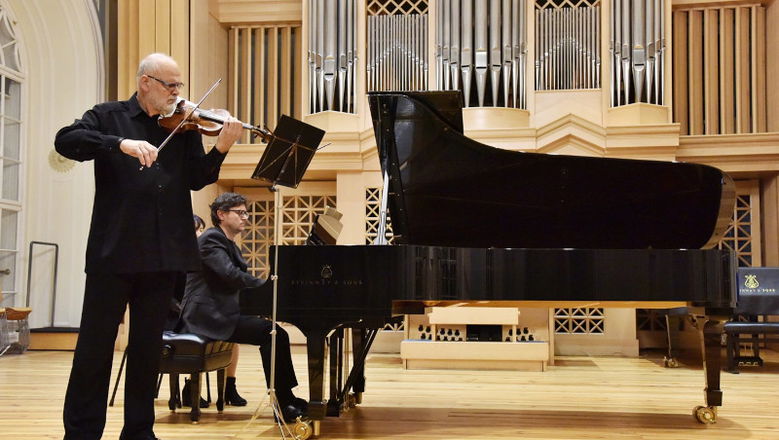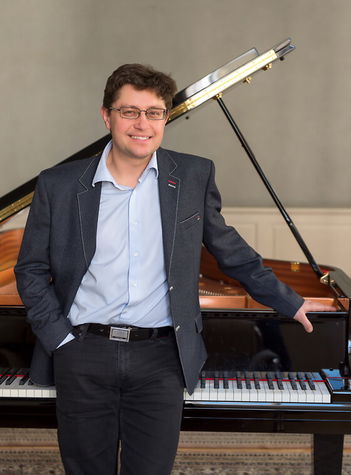Programme
Antonín Dvořák
Violin Sonata in F major, Op. 57
Bohuslav Martinů
Intermezzo (four pieces for pro violin and piano), H 261
Johannes Brahms
Violin Sonata No. 3 in D minor, Op. 108
Secure your seat for the 2025/2026 season – presales are open.
Choose SubscriptionWe will open the series of matinees concerts with a proven combination of violin and piano. Bohuslav Matoušek—renowned soloist, chamber musician, and pedagogue—will present shorter pieces by his namesake Bohuslav Martinů, alongside sonatas by close friends Antonín Dvořák and Johannes Brahms. Dvořák’s contribution is a particular rarity: the only surviving work he ever labelled as a sonata.
Subscription series DK | Czech Chamber Music Society
Antonín Dvořák
Violin Sonata in F major, Op. 57
Bohuslav Martinů
Intermezzo (four pieces for pro violin and piano), H 261
Johannes Brahms
Violin Sonata No. 3 in D minor, Op. 108
Bohuslav Matoušek violin
Miroslav Sekera piano

Bohuslav Matoušek violin
Miroslav Sekera piano

Miroslav Sekera, winner of the 2002 Johannes Brahms International Competition in Portschach, Austria, had already won prizes at many important competitions in this country and abroad (F. Chopin International Competition in Mariánské Lázně, YAMAHA Scholarship Competition, International Piano Competition in Gaillard, France). In 2016 he won a prize from the “Salon de Virtuosi” music society in New York.
He has two solo CDs to his credit, which have won awards on the website Pizzicato.lu; for Joseph Summer, a contemporary composer from Boston, he has recorded seven more CDs in the USA. He collaborates with Czech Radio and with leading Czech orchestras and festivals, including a solo recital at the Rudolf Firkušný Piano Festival at the Rudolfinum. He makes guest appearances abroad, especially in Japan and the USA.
He performs regularly with violinist Josef Špaček, mezzo-soprano Dagmar Pecková, and French horn player Radek Baborák.
He began playing piano at age three and graduated from the Prague Conservatoire (Eva Boguniová and Martin Ballý) and the Academy of Performing Arts in Prague (Miroslav Langer).
Antonín Dvořák
Violin Sonata in F major, Op. 57
Bohuslav Martinů
Intermezzo (four pieces for pro violin and piano), H 261
Johannes Brahms
Sonata for Violin and Piano No. 3 in D Minor, Op. 108
Johannes Brahms composed his first sonata for violin and piano (Op. 78) in 1878, the second (Op. 100) eight years later. Both are written in a major key and both radiate joy and happiness throughout. Brahms’s last violin sonata, Sonata for Violin and Piano No. 3, Op. 108, in D minor, is markedly different, which is audible from the very outset of the introductory movement. Of particular interest in the development section is the pedal point, sustained for over 40 bars, above which the first and second subjects contend and wildly explode. The second movement, featuring a gentle, engrossing melody, is the very opposite of the introduction, yet it is evident that the tranquillity is just temporary. The third, scherzo, movement may be characterised as “nervous”, with its accumulated unrest venting in the thunderous finale. Brahms’s third violin sonata is far from being intimately lyrical, which usually applies to compositions of this type, and when it comes to the technical requirements placed on the performers, it is clearly a concert piece. Dedicated to the pianist and conductor Hans von Bülow, it premiered on 21 December 1888 in Budapest, with Jenő Hubay (1858–1937) playing the violin and Brahms on the piano. The programme of the concert also included Brahms’s String Quartet in G major and songs, which were performed by the Czech tenor Gustav Walter. According to the press reports, the audience responded with standing ovations and the slow movement of the violin sonata had to be repeated.
We will open the series of matinees concerts with a proven combination of violin and piano. Bohuslav Matoušek—renowned soloist, chamber musician, and pedagogue—will present shorter pieces by his namesake Bohuslav Martinů, alongside sonatas by close friends Antonín Dvořák and Johannes Brahms. Dvořák’s contribution is a particular rarity: the only surviving work he ever labelled as a sonata.